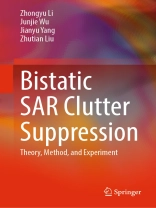This book reports the latest results in the study of clutter suppression and signal processing techniques and focuses on the analysis of non-stationary characteristics of bistatic SAR clutter, DPCA-based clutter suppression method, optimization-based clutter suppression method, sparse recovery-based clutter suppression method, experimental verification and many other aspects, i.e., including the research results of realization technology and experimental verification. Bistatic SAR clutter suppression is the prerequisite and key technique for realizing the detection of moving targets on the ground/sea surface. It is also the frontier and difficult issue of international research in the field of radar. Researchers, engineers and graduate students in radar signal processing can benefit from this book, who wish to learn the core theories, methods and applications of bistatic SAR technologies.
قائمة المحتويات
1. Introduction.- 2. Basic Theory for Clutter Suppression.- 3. Signal Model of Bistatc SAR Clutter.- 4. DPCA-Based Clutter Suppression Method.- 5. Optimization-Based Clutter Suppression Method.- 6. Sparse-Recovery-Based Clutter Suppression Method.- 7. Experiment Technique Existing Challenges and Future Work.
عن المؤلف
Zhongyu Li is the winner of the Outstanding Doctoral Society Award of the Chinese Institute of Electronics, and he was successfully selected for the China Postdoctoral Innovative Talent Support Program. He received the B.S. and Ph.D. degrees in Electronic Engineering from the University of Electronic Science and Technology of China (UESTC), Chengdu, China, in 2011 and 2017, respectively. From 2015 to 2016, he was a visiting Ph.D. student with the Department of Information Engineering, Electronics and Telecommunications, Sapienza University of Rome, Rome, Italy. He is currently an associate professor with UESTC. His research interests include synthetic aperture radar technology (particular emphasis on bistatic/multi-static SAR moving target detection and imaging technologies).
Junjie Wu is the winner of the Outstanding Youth Fund of the National Natural Science Foundation of China. He received the B.S., M.S., and Ph.D. degrees in electronic engineering from the University of Electronic Science and Technology of China, Chengdu, China, in 2004, 2007, and 2013, respectively. He is currently a professor with the UESTC, Chengdu. From January 2012 to January 2013, he was a visiting student with the Department of Electrical and Computer Engineering, Duke University, USA. His research interests include synthetic aperture radar imaging (particular emphasis on bistatic synthetic aperture radar).
Jianyu Yang is a fellow of the Chinese Institute of Electronics. He received the B.S. degree in electronic engineering from the National University of Defense Technology, Changsha, China, in 1984 and the M.S. and Ph.D. degrees in electronic engineering from the University of Electronic Science and Technology of China (UESTC), Chengdu, China, in 1987 and 1991, respectively. He is currently a professor with the School of Information and Communication Engineering, UESTC. His research interests are mainly in synthetic aperture radar (SAR) and statistical signal processing.
Zhutian Liu: Zhutian Liu received the B.S. degree in electronic engineering from the University of Electronic Science and Technology of China (UESTC), Chengdu, China, in 2015, where he is pursuing the Ph.D. degree with the School of Information and Communication Engineering. His research interests include synthetic aperture radar clutter suppression and ground moving target detection.












